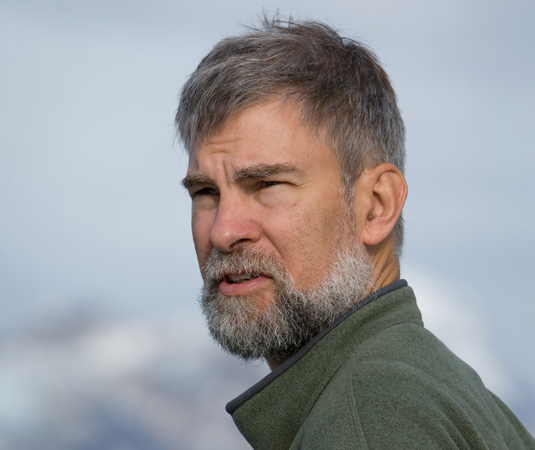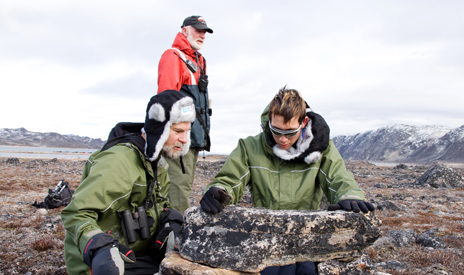

Environmental educator
Doug Fraser
by Leanne Miller, OCT
photography by Robert vanWaarden
Drive six hours or about 550 kilometres north from the shores of Lake Ontario
and you’ll find yourself on the shores of Lake Temiskaming. In the last hour
or two you may see moose on the side of the quiet highway, as well as a touch
of snow in the bush, even though it’s May.
You’re far from the Mowat Block, the downtown Toronto home of the Ministry
of Education and the supposed centre of education in Ontario. But don’t be
fooled; the geography is irrelevant. What’s happening in Room 216 at Timiskaming
District SS in New Liskeard is at the leading edge of education in the province.
Meet Doug Fraser, OCT, science teacher, department head, environmental activist,
co-author of seven textbooks and consultant for an eighth (with three more
in the works), 2007 Outstanding Biology Teacher of the Year – and now, a winner
of the Premier’s Award for Teaching Excellence in the Lifetime Achievement
category.
Fraser has long been a proponent of making science practical, hands-on and
real for students. He is energized by what he calls the province’s “honest
and significant commitment to education and the environment” and thrilled with
the main goal of the 2008 science curriculum: relating science to technology,
society and the environment, also known as STSE.
“What that means,” he enthusiastically explains, “is that teaching the applications,
the achievements and the impacts of science is as important as teaching the
core science – the theories and concepts.”
The introduction to the new curriculum document quotes Lynn Erickson’s Concept-Based
Curriculum and Instruction: “Change the focus of the curriculum and instruction
from teaching topics to using topics to teach and assess deeper, conceptual
understanding.”
“In other words, the new STSE approach allows teachers to truly engage students
in ways not possible before,” says Fraser.
“We’ve been too busy covering the contents and hoping there would be time
for the fun stuff at the end of the year,” he explains. “STSE encourages us
to begin each unit with practical, real-world, why-are-we-learning-this activities
that will hook students and lead them to ask, ‘Why?’ Once we have their attention,
we can focus on the theory and the concepts.”
He’ll use an STSE approach as he co-ordinates the development of new teaching
resources and a forthcoming science textbook. As always, he’ll make sure that
lots of innovative activities are included.
Over 15 years ago Fraser began to explore the then-revolutionary concept of
DNA fingerprinting with his students. Today it’s commonplace in science curricula,
but it was practically science fiction back then.
“He inspires both adults and students with his knowledge and enthusiasm.”
He remembers learning about the first mapping of the complete genetic code
of a living organism in 1995. He excitedly downloaded and printed all 160 pages
(580,000 letters) of the DNA sequence from the then relatively new Internet
and brought them into the classroom to share with his students.
“It was a scientific and technological landmark achievement,” Fraser says.
“And it led to the mapping of the entire human genome eight years later.”
Technical innovation
He continues to teach innovative genetic technologies in his classroom, including
the transfer of genes from jellyfish into bacteria.
“Students struggle to learn important but abstract concepts they cannot see,”
Fraser explains. “For example, the structure of complex macro-molecules cannot
be directly observed in the classroom, nor can the evolution of a species.”
Such challenges motivated him to develop computer-modelling programs that
would make these important and fascinating concepts accessible to students
in engaging interactive ways. The programs allow students to explore and manipulate
molecules that contain thousands of atoms and to literally watch virtual species
evolve before their eyes.
Fraser shares his ideas with fellow science teachers at the annual conference
of the Science Teachers’ Association of Ontario, where he is a regular presenter.
He is well known for the diversity of his topics – from pseudo-science and
the paranormal to evolutionary biology, chaos theory and climate change. He
never fails to entertain and educate while he encourages fellow teachers to
incorporate new and innovative topics and techniques into their repertoires.
Fraser is convinced that students must understand the point of what they are
learning and have the chance to conduct their own investigations.
“When I teach a topic – atomic theory, electricity or astronomy – I try to
ensure that my students appreciate its relevance and importance to their own
lives and to society as a whole. When they see the significance, they are more
willing to engage fully.”
Technology paired with innovative teaching is one aspect of Doug Fraser. Another
is the environment – both local and global.
“He’s one of the most committed men to environmental education and the well-being
of our planet I have ever encountered,” says principal Jim Rowe, OCT. “Equally
important, he inspires both adults and students with his knowledge and enthusiasm.”
Fraser came to his career and his passion for the environment while working
in Algonquin Park the summer after he completed his BSc in biology. He was
thinking of pursuing graduate studies but realized he’d have more impact working
with high school students.
Always an environmentalist and an activist, Fraser was involved with local
environmental non-governmental organizations in the 1980s. He was part of a
group that encouraged government action on global warming and produced a publication
titled Degrees of Change.
In the late 1990s he was active in the successful opposition to the Adams
Mine project. The City of Toronto had proposed dumping its municipal waste
in an abandoned open-pit mine in the Timiskaming area. Though it would mean
an investment of millions of dollars in the local community – as well as new
jobs and ongoing revenue – Fraser and others argued that the environmental
impact would be too great and the precedent too dangerous.
 |
| Assisting Nunavut student Devin to construct an Inukshuk on Baffin Island
during the 2008 Cape Farewell Youth Expedition |
Communicating Darwin
More recently, Fraser’s work on behalf of the environment has gone global.
In October he attended an international education symposium in York, England
as part of an invited audience of teacher educators, policy-makers and specialists
in education and public engagement. The symposium, titled Communicating Darwin’s
Ideas, was one of countless events marking the 150th anniversary of the publication
of Charles Darwin’s On the Origin of Species.
“It’s a big year for biologists,” says Fraser.
In 2008 Fraser was chosen from thousands of volunteers who applied to be part
of a special training event titled Climate Project Canada. Fraser and about
250 other Canadians convened in Montréal where Al Gore, David Suzuki, Andrew
Weaver and other leaders in climatology and the environment gave presentations
and provided expert opinion on climate change.
As part of their commitment, the volunteers pledged to make 10 presentations
in their local communities to raise awareness about the climate-change crisis.
Fraser estimates that he has given at least 20 such presentations to community
and school groups in his area.
Fraser likes to remind his students and the public just how fortunate they
are. Relative to almost all humans who have ever lived, Canadians have an extremely
high standard of living, which includes material wealth and excellent health
care and education. He believes that our good fortune brings both benefits
and responsibilities.
“We have a duty to act in a sustainable way – to care for the planet and act
accordingly,” Fraser says.
He regularly brings elections and other societal topics into classroom discussions
and debates. It’s not just science. Equally important is how science affects
society and the environment.
“Instead of judging politicians on how much they will give us,” he says, “I
challenge students to encourage politicians to champion policies that are more
sustainable and just.”
Fraser describes his award-winning teaching style as using approaches based
on inquiry and critical thinking. “It’s not just about doing. It’s about
doing, thinking and critiquing what we do.”
It’s also about variety.
Varied venues
Over the years Fraser has organized, supervised and participated in student
trips to Costa Rica, Belize, Panama, the Amazon and the Galapagos Islands.
“Every venue offers a unique opportunity to create highly effective learning
experiences for students,” he explains, “whether it’s the classroom, the computer
lab, a local bog or a tropical rainforest.”
Last year he and two colleagues successfully applied for a student from their
school to represent Ontario in the 2008 Cape Farewell Youth Expedition, organized
in collaboration with the British Council of Canada. Twenty-eight students
from countries around the world explored Iceland and the coastlines of Greenland
and Baffin Island and experienced first-hand the effects of climate change.
The students were accompanied by teachers, scientists, artists, guides, a media
team and a ship’s crew of 30. Fraser joined the expedition as one of two science
educators.
During the unforgettable two-week trip, participants studied climatology,
oceanography, biogeography and geomorphology. They visited communities and
people affected by a warming climate and melting ice. It was the experience
of a lifetime for Fraser and Timiskaming District SS student, Sarah.
“Mr. Fraser was the humble, smart guy on the trip,” Sarah remembers. “He opened
our minds to so much but made sure we had fun while we were travelling and
learning. The other kids thought so too, not just me.”
Fraser was subsequently asked to develop science lessons for a resource based
on the expedition. These included differentiated instruction, hands-on activities
and real-life applications designed to engage students and examine the serious
impact of climate change on our planet.
Although only one student from Fraser’s school was eligible for the trip,
many of his students were involved in the project. They planted 2,500 trees
for the Elk Lake Community Forest (ELCF), which in turn donated the money necessary
to cover the school’s contribution to the expedition. Established in 1991 under
the Ontario Ministry of Natural Resources, the ELCF initiative involves local
communities in resource management.
Evan was one of the student tree planters on this project.
“Mr. Fraser gets excited about things and it rubs off on us. His teaching
approach isn’t just books, questions and answers. He lets us learn by doing,
by experiencing things first-hand. That’s really cool.”
Brett agrees. “He loves teaching and it shows. He makes us as enthusiastic
as he is. We didn’t even mind planting those trees, with all the bugs out there.”
“You know what else is really important,” says Evan. “He walks his talk. The
man is over six-feet tall and he drives a Smart car! Everyone knows him in
town – he’s the one driving the yellow Smart car.”
“We have a duty to act in a sustainable way – to care for the planet and act
accordingly.”
Melanie explains that assignments are posted on Fraser’s web site and that
students e-mail their work to him. There’s little wasted paper in this class.
“He goes crazy when food comes with unnecessary packaging,” Olivia says. “And
now it makes me crazy too. Why does a coconut need to be wrapped? He got us
to e-mail the Dole Food Company to complain that their organic bananas are
being sold locally in plastic bags.”
Geographically far away from the so-called corridors of power in education,
yet on the cutting edge. That’s where you’ll find Doug Fraser.
To access Cape Farewell videos and downloadable lesson plans for educators,
go to www.capefarewell.com. |












